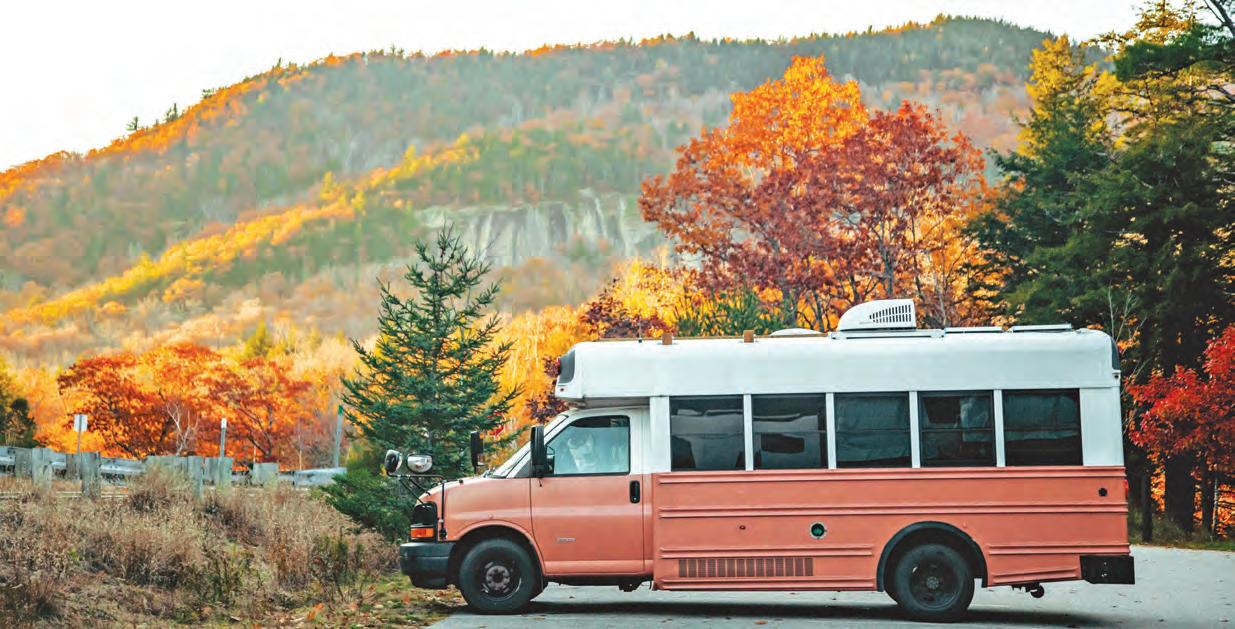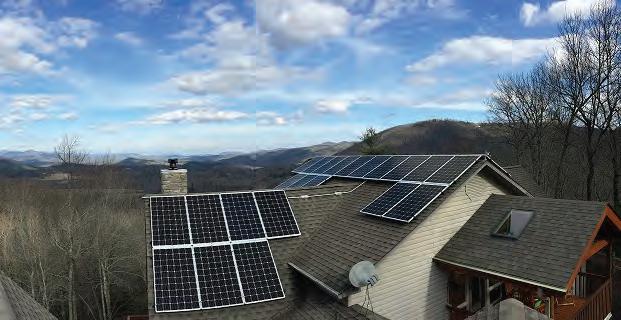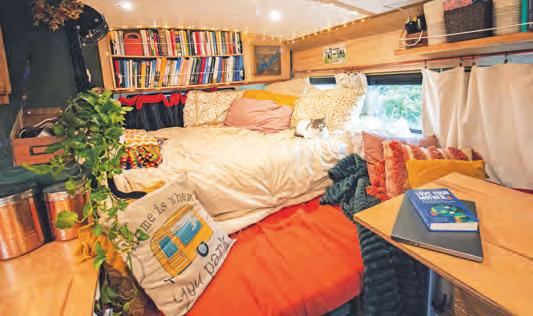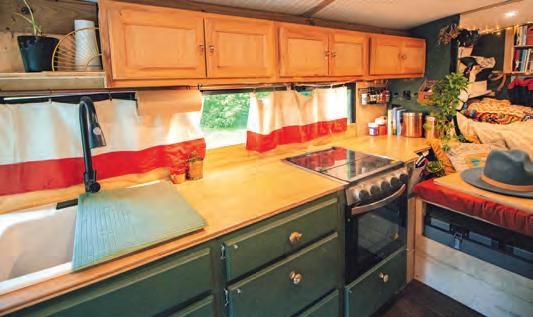
5 minute read
Anyone Can Build a Tiny Home
Tiny Houses Can Make Home Ownership More Accessible and Sustainable
BY KALEN BRELAND
Most of us dream of owning a custom-built home, designed just for us, but that dream can be very costly and nearly impossible for first time homeowners. However, I achieved it at just 24 years old, with some caveats. First — I built it all myself. And second — it was a tiny home, a miniscule 60 square feet.
Since 2020, I’ve self-built two tiny homes inside vehicles. The first was a cargo van shell, but with creative design and modular furniture, I was able to have: a full sized bed, seating for four people; a full desk; an oven, two-burner cooktop, fridge, and freezer; a solar-powered electrical system; storage for my outdoors gear; 18 gallons of freshwater plumbed to a kitchen sink; a four-foot bookshelf; and more countertop space than many people living in urban apartments! The entire home, including the van itself, cost me less than $25,000. And when I finished, the van was worth nearly $50,000.
I purchased my second, and current, tiny home shell — a short school bus — in 2022. This was a huge upgrade — to 100 square feet — so it has everything the first one had but more countertops, storage, water and solar panels, as well as a rooftop deck and small bath- room. By reusing items from the van, and thrifting or salvaging many materials, this one cost just $17,500. As the average rent for an Asheville one-bedroom has reached $1,400, my bus pays for itself within a year, and is significantly cheaper than owning and maintaining a traditional home.
Building these spaces on my own was not an easy task. When I began the first build, I had never used a power tool before, and certainly didn’t own any. I bought tools second hand, learned everything from online videos and blogs, and built it with only a jigsaw, circular saw, and drill. I had a professional look over my electrical and propane systems to make sure they were safe upon completion, but saved thousands by doing the work myself.
My electrical system consists of 400 watts of solar panels and 300 amp hours of lithium batteries. By using DC (direct current) appliances, I can power nearly everything in my home, including my refrigerator, off of solar! DC power is naturally more efficient, and it comes directly from the batteries, saving energy that would be lost in conversion to AC (alternating current) power. My house outlets and air conditioning are the only loads that require an inverter or shore power, respectively.
But electricity wasn’t the only sustainability consideration I included in my tiny home. I used sheep’s wool insulation, which is highly effective, quickly renewable, entirely nontoxic and moisture wicking. It does have a higher price point, but you need much less of it to insulate a tiny home. I thrifted insulated blackout curtains and used a sewing machine to modify them, cut up my old twin mattress to make custom couch cushions, and built my subfloor and bed frame out of plywood removed from a cabin set to be demolished. Even my kitchen sink came from a recycled building materials store, and my curtain rods are made of reclaimed copper pipes.
Of course, if you’re intimidated by doing your own plumbing and electrical work, there are also local professional builders who specialize in tiny homes. Jeramy Stauffer is a local full service tiny home contractor who delivers turn-key homes with all of the necessary design, site work, and construction. Stauffer explains that the price per square foot often seems high for a
Project Team
Builder — Kalen Breland
Building Assistant and Seamstress — Constance
Breland
Demolition Assistant —
Martin Breland
Sheep’s Wool Insulation —
Havelock Wool
Solar Power Kit (including batteries and inverter) —

Renogy
DC Appliances — MaxxAir, ICECO, Dometic, RecPro
Recycled and Salvaged
Materials — Habitat for Humanity ReStore of Huntsville, AL; Mike’s Merchandise of Guntersville, AL; Martin and Norris Breland
Interview — Jeremy Stauffer of Nanostead tiny home because you still need the major infrastructure of a foundation, framing, electrical, kitchen, and bathroom. However, in the end, you still pay less than a third of the cost of building a traditional home.
Many homeowners are worried about building codes for their tiny homes, but professional tiny home builders are knowledgeable of these restrictions and prepared to work with them. Stauffer, for example, can build both tiny homes on wheels that meet RV restrictions, and homes on traditional foundations that meet local building codes.
In addition to custom builders, there are tiny home communities. These communities offer the same perks of living in an HOA without the typical higher costs of living in those neighborhoods. Here in Western North Carolina, we have planned communities which build and sell stationary tiny homes, as well as ones that rent out spaces for tiny homes on wheels.
Of course, tiny living to my extreme is not for everyone. If you have kids or large dogs, 100 square feet may not be practical. However, a home is considered a “tiny house” up to 400 square feet, and remember that the careful and intentional design of most tiny homes allows for far more storage, functionality, and privacy than a traditional 400 square foot space.
The tiny house movement largely attracts people for the mental benefits. Owning fewer material possessions, tiny house advocates argue, allows you to live with more freedom, peace, and mental clarity. But tiny homes have tangible advantages for even the most practical people — financial freedom and a lower environmental impact.
“Not only are you being sustainable to the earth by building something smaller, but you’re being sustainable to yourself by not spending all your time paying for something that you don’t really need,” Stauffer explains. The average cost of a tiny home in 2022 was $52,000, compared to over $400,000 for a traditional single-family home. But the savings don’t stop at the deed — small spaces are easier to heat, cool, power and clean, leaving you with significant savings on energy bills and personal time.
I have loved living tiny for the financial freedom, mental clarity and more sustainable lifestyle it offers. My home uses only 15 gallons of water a week; I’m far more intentional with my purchases due to limited storage; I spend more time outside; I can travel for extremely low costs; my energy bills are nonexistent; and my “rent” each month ranges from $0-$500.
But at the end of the day, the self-sufficiency of tiny living is still one of the biggest driving factors. According to Stauffer, his biggest client group for tiny homes is sin- gle women over 30 looking for the independence and freedom of home ownership at a lower price point. Stauffer even teaches DIY Tiny House Building classes, and says 90% of his students are women looking for the basic skills and confidence to take control of their lives by building their own homes, just as I did.


If you think tiny living may be for you, reach out to a local builder for a consultation, watch some tiny home tours online, or book a tiny vacation rental to try it out for a weekend! With the freedom of minimal living, the financial inde- pendence of low-cost homeownership, and the low environmental impact of tiny homes, it’s hard to imagine anyone who wouldn’t benefit from a smaller, more carefully designed home.
Kalen joined Green Built Alliance in the spring of 2023 as a Membership and Communications Coordinator. She loves to travel and hike, but after three years of building and traveling in DIY tiny homes, she has settled in Asheville. When she’s not at work, you can find her foraging, reading, or with her two beloved cats, Biscuit and Poppyseed.










